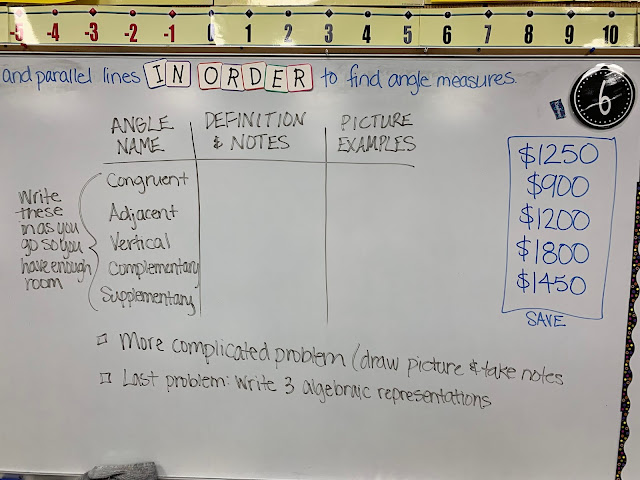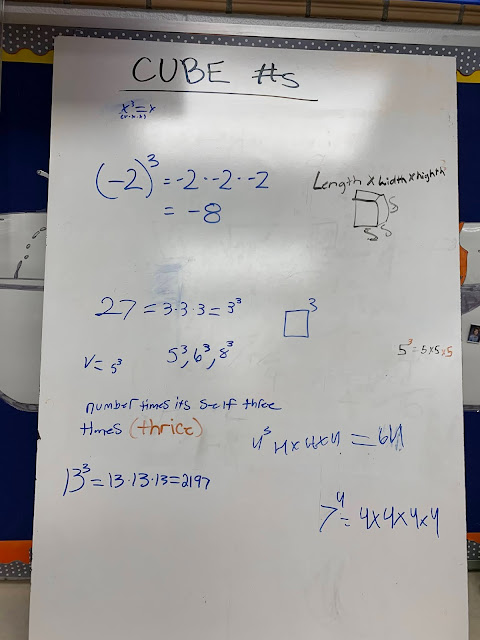Monday, December 27, 2021
Grades this Semester
Wednesday, December 15, 2021
Moving to the Floor
It's not a vertical white board,
Tuesday, December 14, 2021
Student Reasons for Their Choice in Learning Activity
Helps me work with others
It helps me
We can visually show how we learn
Talking with someone and adding me and the person’s brain to see what we understand
Helps me see it in front of me
Get to talk to other people and see what they are doing
It helps me like the notetaking that follows
We have partners to work with and show us our mistakes
I can use my partner’s knowledge to understand it better
Video note-taking helps me remember
I can go back to it and study
I can go back and look at it
Helps me study whenever
It keeps me focused and when I forget something I can look at them.
Writing it down helps me learn it
Helps me remember better
Writing things down helps me remember better & easier to study
If I forget something i can look back into my notes
You can look at it at home and study for the quiz
So I can go over it whenever!
I can see what others have to say, plus what they are questioning
Everyone gets a chance to say what they think.
Everyone gets to answer and you can hear other people’s thoughts
If I get it wrong and look at the answer key I can see where and how I messed up and retry to understand it and get better
Helps me with studying
So I can see how much I know
You can do your work, check your answer and see your mistake
When I check it on my own, I get a better understanding
A lot less stress and if you get it you don’t have to do the rest
If I don’t finish it, it won’t bring my grade down
I don’t have to worry about making mistakes
It keeps my grade up
I don’t stress as much
It lets us make mistakes without having a consequence
Helps me learn and not to do it wrong again
Helps me see what I did so I can learn from it
So I can go back and learn better
When I make mistakes I feel like I learn it and figure it out more easier because a teacher or someone else will explain it to me better and I will understand it.
You learn from your mistakes
Thursday, December 9, 2021
From the Students' Perspective
Friday, December 3, 2021
Taking Notes
Thursday, December 2, 2021
When Students Realize That They Just Think Better At the Boards.
Thursday, November 18, 2021
Wednesday, November 17, 2021
Marzano's Nine Instructional Strategies Meets BTC
Friday, November 5, 2021
Notes for My Future Forgetful Self Meet the Vertical White Boards
Thursday, November 4, 2021
When We Must Focus On Things OTHER Than Math
Thursday, October 21, 2021
No Grades and Answer Keys (Ch. 7)
Scratch Paper Lotto
Tuesday, October 19, 2021
Vertical White Boards for the Win!
Monday, October 18, 2021
Versatile Vertical White Boards
Thursday, October 14, 2021
Four BTC Strategies Earn their Respectful Place in the Top Six Learning Modes for RVMS Students
⚝ Vertical white boards with random groups (BTC) ⚝ EdPuzzle Video
⚝ Check Your Understanding Worksheet with answer keys for feedback (BTC)
⚝ Visualizing the problems with Algebra Blocks ⚝ Whole Class Discussions (BTC)
⚝ Anchor Chart (poster) for solving equations ⚝ Notes for My Forgetful Self (BTC)
⚝ Clicker Quiz Review at the Vertical White Boards (MSM) ⚝ Finding the Mistake lesson
⚝ Analyzing the first quiz ⚝ Escape Room practice problems
⚝ Fraction lessons with solving equations ⚝ Simulation Trainer (MSM)
MSM - MidSchool Math Curriculum BTC - Building Thinking Classroom Strategy
Students were to pick their top three learning activities
that best helped them understand how to solve equations.
OVERWHELMINGLY, the #1 learning activity
was VERTICAL WHITE BOARDS (Ch. 3) with 44 out of my 65 students choosing this learning activity.
Tieing for second was Whole Class Discussions/Consolidate Thinking (Ch. 10)
and the Escape Room.
Whole class discussions did not surprise me,
As these are year after year one of my students' favorite learning modes.
The Escape Room was ranked this high,
According to my students,
Because it was just plain fun.
They literally were doing about 20 problems,
But the challenge of moving levels made it fun and engaging.
Rounding out the top six was
Clicker Quiz Reviews,
Notes for my Future Forgetful Self (Ch. 11)
And Analyzing the quiz (Ch. 13).
In summary, out of the top six learning activities,
Four were from BTC strategies!
Students were also to pick the least helpful learning activity. And this came as no surprise either.
The online EdPuzzle Lesson ran away with the least helpful title.
Students don't want passive learning experiences.
They want to talk about the math.
They want to see the math.
They was guidance and feedback.
While an EdPuzzle does contain 3 of the 4,
It's the interactive conversation piece that's missing.
And that's an important piece in learning...
Being able to share and talk about it.
Overall observations from Quiz 1 to Quiz 2.
--> Confidence rose. Students were completing the quiz in a shorter amount of time.
--> Work shown was more organized, more complete, more accurate.
--> Students handed in the second quiz with a sense of pride.
--> Growth occurred. Some increased their grades by 50-60 points.
--> Quiz 2 was easier to grade. More correct answers. Algebraic rules were followed making it easier to find their mistakes.
Questions resulting from these very positive observations.
--> Did these changes happen from the activities used in reteaching?
--> Was quiz 1 a wake-up call and students paid more attention to reteaching?
Concern
We won't have time to always allow a week of additional teaching. I chose to do so with this concept of solving equations as this is a skill that will follow them their entire mathematical education.
What happened today...the day after the quiz.
A student asked, "Are we at the boards today?"
With a total begging look in his eyes.
When I answered yes,
The entire class cheered.
They cheered.
Let that sink in.
They were excited about doing math together.
Thursday, October 7, 2021
Using Self Reflection on Assessments (Ch. 13)
Tuesday, October 5, 2021
No Grades When Learning = More Thinking
Becoming Habit
Tuesday, September 28, 2021
Making It Our Own
- Give thinking tasks
- The tasks from the curriculum are usually the Data/Computation problem from the intro lesson
- Sometimes the tasks have been practice problems that vary in complexity
- Frequently form visibly random groups
- Most of the time, we have formed random groups. Sometimes due to time constraints, they move to a board in their table groups
- Use vertical non-permanent surfaces
- We have varied this approach. Sometimes using horizontal large group boards or even individual boards so everyone can work on the problem
- Defront the classroom
- This was easy. I already had two "fronts"...my large whiteboard and the TV. Now I just added all the vertical boards into my teaching focal points.
- Answer only keep thinking questions
- Give thinking task early, standing and verbally
- We don't always stand anymore, but the thinking task is always given at the beginning of the hour.
- Give check-your-understanding questions
- The Practice Printable from our curriculum has worked great for checking for understanding. I do not take grades on these, but instead encourage students to check where they are at. Would they be able to take a quiz the next day based on how they know the content we have been working on? After getting feedback from the answer key, students code their work with a checkmark to show the correct answer, an X if it's incorrect, an H if the answer key helped them, a G if their group helped them.
- Mobilize learning
- Students are learning that they can use what they see on other boards to help them move their thinking instead of remaining stuck.
- Have students writing meaningful notes
- This is an area that needs a lot more practice! We will continue to work on these skills of getting meaningful notes down in writing.
































